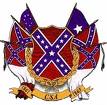From SLMN Blog and The Washington Post:
Descendants want Civil War soldiers' burial site at Point Lookout marked
Just outside Point Lookout State Park, a federal monument to more than 3,000 Confederate soldiers buried nearby is undergoing a $250,000 restoration. A group wants to mark the actual burial trench. (Jesse Yeatman/the Enterprise) Network NewsX Profile
By Jesse Yeatman
The Enterprise
Thursday, July 15, 2010
A battle has broken out over a federal memorial for Confederate soldiers who died at Point Lookout during the Civil War.
"Since last August, we've been trying to get the [U.S. Department of Veterans Affairs] to mark the mass-burial plot," Jim Dunbar said.
Dunbar has ancestors who died at the Union prisoner of war camp at Point Lookout. He is a member of the Descendants of Point Lookout Prisoners of War Organization.
Point Lookout's use as a prison camp began after the Confederate defeat at Gettysburg, Pa., in July 1863. Between 1863 and 1865, more than 50,000 prisoners passed through the camp.
Because of erosion at grave sites, the remains of more than 3,300 people were moved from their original resting places in 1910 to a burial trench, near where a federal monument was constructed that year. An 80-foot granite obelisk marks the site, just outside Point Lookout State Park, but the actual boundaries of the pit are not marked.
Archaeologist James Gibb of Annapolis connected with the group and offered to perform a free dig to determine the trench's boundaries. However, the National Cemetery Administration, an arm of the Department of Veterans Affairs that oversees the memorial and grave site, denied his request.
Gibb wanted to dig one to two dozen small holes, up to a foot deep, to discover and mark the boundaries of the pit, which is believed to be about 20 feet by 20 feet and behind the monument.
Gibb said the survey would take little effort and not disturb the remains.
"If [the remains] are less than a foot deep, then we're the least of their problems," Gibb said. "I've worked on cemeteries like this a lot. . . . There's no risk here."
Gibb has been an adjunct professor at several colleges and worked as a self-employed archeologist consultant, conducting surveys and site examinations in Maryland for 30 years. He has a doctorate in anthropology from Binghamton University. The group contacted Gibb through a mutual friend who had helped with a cemetery project at nearby Patuxent River Naval Air Station.
Gibb sent the application in May 2009. In October, Steve Muro, the NCA's acting undersecretary for memorial affairs, denied the request.
"NCA's mission is to honor veterans with final resting places and provide tributes of their service," said Michael Nacincik, a spokesman for the NCA. "The administration will not disturb the remains of buried soldiers unless necessary."
Based on Gibb's request, Nacincik said, "veterans' remains could be disturbed. "We also believe that the burial site is appropriately marked."
Nacincik said it is uncommon to mark the actual boundaries of burial trenches, unless markers were put in when the burials occurred.
The NCA is conducting a study on all Confederate plots, including the one at Point Lookout, and is developing interpretive signs and plaques. The NCA, along with the help of the contractor hired to design the signs, will determine what information is portrayed.
Nacincik said he realizes that some people are upset about the decision, but that the NCA is trying to accommodate them. An offer for the archaeologist and the preservation group to use ground-penetrating radar was declined; Gibb said it would cost several thousands of dollars to hire someone with the right equipment.
The fate of the Confederate remains at Point Lookout never has been clear-cut or without controversy.
The Descendants of Point Lookout POW Organization Web site describes the camp as "a genocidal, ethnic cleansing, concentration camp filled with federal atrocities that housed over 52,000 Southerners, with a death count of over 14,000."
The Commission for Marking the Graves of Confederate Dead, made up of former Confederate soldiers, which operated from 1906 to 1912, signed off on the current Point Lookout cemetery, including the obelisk memorial, Nacincik said. A $250,000 renovation to the 80-foot-tall federal monument, spearheaded by the NCA, is under way. In addition to the mortar work, the 12 bronze plaques bearing the known names of Confederates who died at the camp will be cleaned, waxed and buffed.
Another point of contention is an alleged lack of names on the federal monument.
The monument contains the names of 3,382 Confederate soldiers and sailors and 44 civilians who died there, according to the NCA. An NCA historian acknowledged that the monument probably is missing the names of some of those who died at the camp.
The late St. Mary's historian, Edwin Beitzell, author of "Point Lookout Prison Camp for Confederates," wrote that the number of people who died there was closer to 4,000.
Enterprise staff writer Jason Babcock contributed to this report.



No comments:
Post a Comment
Note: Only a member of this blog may post a comment.